Deborah J. Ross's Blog, page 131
May 13, 2014
Baycon schedule
Please drop by, listen to what are sure to be some fascinating conversations, and say hello!
1. Refurbished History: Looting the Past for Fun and Profit on Saturday at 10:00 AM in Stevens Creek (with Professor David C. McGaffey, Irene Radford (M), Kyle Aisteach, David Weber, Chaz Brenchley) Is it cheating to mine the past for story elements? Can you leave identifiable marks as long as they don't disrupt your story? And what about retooling historical figures? When is using identifiable places or characters truly a better choice than being original?
2. The Unpanel: Deep Listening on Saturday at 2:00 PM in Napa III (with Dave Trowbridge) This panel is a way to come down from the ego-high of an SF Con and spend an hour being heard, rather than just talking.
3. Countering Online Hate Speech on Saturday at 3:30 PM in Alameda [I am moderating.] (with Amy Sterling Casil, Colin Fisk, S.L. Gray, Robert Lawrence) Online hate speech can devastate the lives of the person under attack and everyone around him or her. Panelists discuss effective online responses, ways to support the person, building tolerant communities, and what to do if you yourself are a target.
4. Alternative Lifestyles and Sci-Fi/Fantasy on Sunday at 10:00 AM in Lawrence (with Lynx Crowe, Douglas Berry, Allison Lonsdale From Heinlein's line marriage to Ethan of Athos, a discussion of alternative lifestyles, chosen or otherwise.
5. Science Fiction: More than a Job, It's an Obsession. on Sunday at 11:30 AM in Ballroom E-F. (with Irene Radford (M), Ursula Vernon, David Weber) It's good for the mortgage, but what's the effect on the author? And how do you stay sane when you hit book 12? How often does a series get out of control and continue long past its prime, and how does it affect the series as a whole?
6. Women and Warriorship on Monday at 11:30 AM in Stevens Creek. (with Setsu Uzume (M), Margaret McGaffey Fisk, Taunya Gren, Sandra Saidak) The controversy surrounding the "Strong Female Lead" (we need more of them! vs. Sophia McDougal's call for a wider variety) is grounded in two ideas: our perception of gender, and our perception of warriorship. We'll discuss historical women warriors as well as figures from sci-fi/fantasy that meet our expectations, those who break them, and what the future has in store for this archetype.
Also, I'll be reading from my Lambda Award Finalist novel, Collaborators, at 9:30 on Sunday, accompanied by Cliff Winning on sitar!

1. Refurbished History: Looting the Past for Fun and Profit on Saturday at 10:00 AM in Stevens Creek (with Professor David C. McGaffey, Irene Radford (M), Kyle Aisteach, David Weber, Chaz Brenchley) Is it cheating to mine the past for story elements? Can you leave identifiable marks as long as they don't disrupt your story? And what about retooling historical figures? When is using identifiable places or characters truly a better choice than being original?
2. The Unpanel: Deep Listening on Saturday at 2:00 PM in Napa III (with Dave Trowbridge) This panel is a way to come down from the ego-high of an SF Con and spend an hour being heard, rather than just talking.
3. Countering Online Hate Speech on Saturday at 3:30 PM in Alameda [I am moderating.] (with Amy Sterling Casil, Colin Fisk, S.L. Gray, Robert Lawrence) Online hate speech can devastate the lives of the person under attack and everyone around him or her. Panelists discuss effective online responses, ways to support the person, building tolerant communities, and what to do if you yourself are a target.
4. Alternative Lifestyles and Sci-Fi/Fantasy on Sunday at 10:00 AM in Lawrence (with Lynx Crowe, Douglas Berry, Allison Lonsdale From Heinlein's line marriage to Ethan of Athos, a discussion of alternative lifestyles, chosen or otherwise.
5. Science Fiction: More than a Job, It's an Obsession. on Sunday at 11:30 AM in Ballroom E-F. (with Irene Radford (M), Ursula Vernon, David Weber) It's good for the mortgage, but what's the effect on the author? And how do you stay sane when you hit book 12? How often does a series get out of control and continue long past its prime, and how does it affect the series as a whole?
6. Women and Warriorship on Monday at 11:30 AM in Stevens Creek. (with Setsu Uzume (M), Margaret McGaffey Fisk, Taunya Gren, Sandra Saidak) The controversy surrounding the "Strong Female Lead" (we need more of them! vs. Sophia McDougal's call for a wider variety) is grounded in two ideas: our perception of gender, and our perception of warriorship. We'll discuss historical women warriors as well as figures from sci-fi/fantasy that meet our expectations, those who break them, and what the future has in store for this archetype.
Also, I'll be reading from my Lambda Award Finalist novel, Collaborators, at 9:30 on Sunday, accompanied by Cliff Winning on sitar!

Published on May 13, 2014 10:15
May 12, 2014
The Tajji Diaries: Confidence and Joy
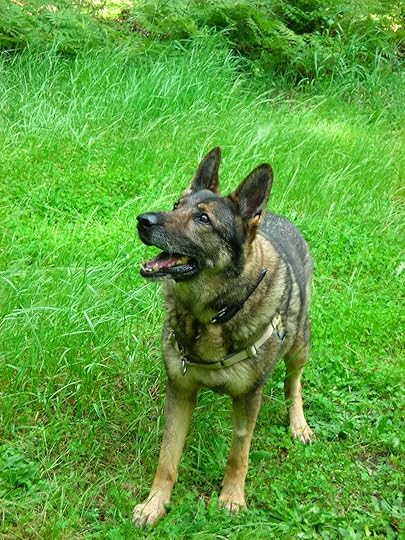 Waiting for the ball Our friend Mitch Wagner recently adopted a female shepherd/basenji/terrier mix that shares some of Tajji’s “issues. He writes that Minnie “lunges and goes nuts when she approaches another dog when we're walking.” One of the things we’ve learned from our trainer, Sandi Pensinger, is that this kind of excitement is not fun for dogs. Whatever their specific history, they act this way because they’re overwhelmed. They no longer can calm themselves or communicate friendly intentions to the other dog. One way to look at this is the dog attempting a “pre-emptive strike” because bad things have happened around other dogs in the past. Dogs on leashes are particularly vulnerable to feeling threatened, because their freedom to act in their own defense (or escape) is impaired. Dogs that are tied up are particularly dangerous.
Waiting for the ball Our friend Mitch Wagner recently adopted a female shepherd/basenji/terrier mix that shares some of Tajji’s “issues. He writes that Minnie “lunges and goes nuts when she approaches another dog when we're walking.” One of the things we’ve learned from our trainer, Sandi Pensinger, is that this kind of excitement is not fun for dogs. Whatever their specific history, they act this way because they’re overwhelmed. They no longer can calm themselves or communicate friendly intentions to the other dog. One way to look at this is the dog attempting a “pre-emptive strike” because bad things have happened around other dogs in the past. Dogs on leashes are particularly vulnerable to feeling threatened, because their freedom to act in their own defense (or escape) is impaired. Dogs that are tied up are particularly dangerous.Another way of thinking about this behavior is in terms of self-confidence and trust. A confident dog with good social skills with other dogs is capable of lowering the tension not only in herself but in the other dog as well. Contrary to the “alpha dog/dominance” model, dogs are highly cooperative, social animals. They communicate their feelings and intentions to one another all the time, and many of these signals are calming signals. In earlier blogs, I’ve discussed how Tajji learned to communicate her peaceful intentions to the cats once she’d found a signal they both understood – the “look-away.” Turid Rugaas’s book On Talking Terms With Dogs: Calming Signalsbeautifully illustrates this. Here is a slide show from her book, illustrating the “look-away,” play bows, lip licking, and lying down, all powerful calming signals.
Dogs who are poorly socialized with other dogs or who have had traumatic experiences can be easily overwhelmed (“flooded” with negative stimuli), especially in situations where the other dog is approaching head-on. A direct approach is threatening, as is fixed eye contact. Our dogs need our help in reducing the degree of threat and resulting arousal. The dogs in Rugaas’s slide show aren’t “friendly” in the human sense, but they have excellent social skills and confidence in themselves.
How do we help a dog re-build her self-confidence?
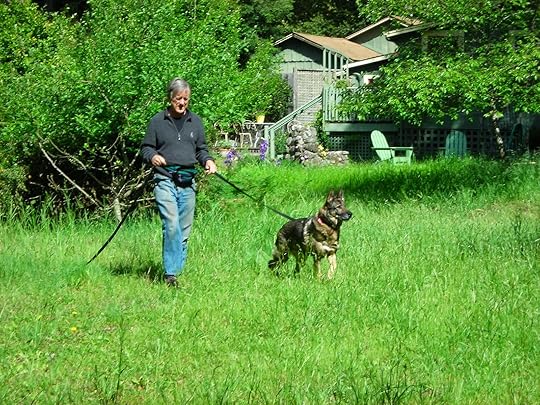 In The Meadow We have recently had some moment of success with Tajji’s reactivity to pedestrians. At first, we had to remove her from the stressful situation (seeing a person on foot several blocks away). At the same time, we rewarded her with click/treat for coming away. Since her tooth extraction, she has been significantly less reactive, so we’ve gone on to the next step – walk away, increasing the distance, then circling to take another look, while click/treat what a good dog!Gradually Tajji began to trust us to heed her signals of distress. She also learned that calm behavior generated many tasty treats and praise.
In The Meadow We have recently had some moment of success with Tajji’s reactivity to pedestrians. At first, we had to remove her from the stressful situation (seeing a person on foot several blocks away). At the same time, we rewarded her with click/treat for coming away. Since her tooth extraction, she has been significantly less reactive, so we’ve gone on to the next step – walk away, increasing the distance, then circling to take another look, while click/treat what a good dog!Gradually Tajji began to trust us to heed her signals of distress. She also learned that calm behavior generated many tasty treats and praise. In the last few days, she’s been able to do a walk-by on opposite sides of a two-lane street with a pedestrian. Several times, her reaction to a distant threat has been to check in with Dave or me. Yes! Good job! Throwing the treat on the ground -- “Find it!” -- not only delivers the treat but encourages her to sniff, which calms her and sends a calming signal to the (human being) scary thing down the street.
For me, a key to working with a fearful, unconfident dog is finding what gives them joy. Some dogs are entirely focused on food, and we’d want to find the most tasty, endorphin-producing treats for them. Other dogs love play – chasing balls, catching Frisbees, romping in the surf. Tajji is moderately food-motivated, but not when she’s too stressed. In fact, not accepting a treat is a good signal (for us monkeys) that she’s in over her head.
Tajji went through a period of time when she absolutely “lit up” when we threw a ball for her. She hasn’t quite gotten the idea to bring it all the way back and hold it until we ask her to drop it, but close enough. About a week ago, while playing ball in The Meadow, I saw her running full-speed after what looked like a cat. The prey animal turned out to be a tiny fawn that had been resting in the bracken ferns that border the meadow. (We’ve since discovered evidence of deer – which infest our neighborhood and ravage gardens – lying down there.) It dashed this way and that, undoubtedly terrified out of its mind. Tajji’s prey drive was fully engaged, and it was difficult to break her “lock” on the fawn, but I managed to interrupt her charge. (The fawn, which she had knocked down several times but not otherwise injured, sprinted away.) Since then, Tajji has been fascinated by deer trails. After a lifetime of not being permitted to sniff while in harness, she is making up for lost time. We are contemplating enrolling her in a “nose work” class with Sandi. Fortunately, we have access not only The Meadow, but a number of privately-owned trails where she won’t encounter other dogs.

Published on May 12, 2014 01:00
May 7, 2014
NEWS FLASH: More Darkover Novels!
 Now that the contracts with DAW and the Marion Zimmer Literary Works Trust have been signed, I can tell you what I’ve been up to: proposals for three more Darkover novels. Here are a few “sneak preview” details.
Now that the contracts with DAW and the Marion Zimmer Literary Works Trust have been signed, I can tell you what I’ve been up to: proposals for three more Darkover novels. Here are a few “sneak preview” details.The first of this new group will be Thunderlord, the long-awaited sequel to Stormqueen! Marion intended to write this novel and left a couple of pages of very rough draft, essentially recapitulating Stormqueen! as backstory, but establishing that the central character (one of them, anyway) would be Renata and Donal’s son, the heir to Aldaran, set against a backdrop of the smoldering feud between Aldaran and Scathfell.
The Laran Gambitcontinues the timeline after The Children of Kings, bringing Darkover and the Star Alliance into conflict and pitting the laran of the Comyn against machine-generated psychic powers.
Arilinn takes us back in time to the founding of the most prestigious of Darkover’s Towers. (And I have a secret hope that if you readers adore Arilinn, I’ll get to write the stories behind the other Towers, too!)
Likely publication dates are 2016, 2017, and 2018, but you never know. Stay tuned for writerly inspiration and more details!

Published on May 07, 2014 20:05
May 6, 2014
Adventures in Author Readings
 Over the decades, I’ve done many readings, and each one has a story behind it. All kinds of things can go wrong at readings. Nobody shows up – that’s the classic “worst fear” of newer (and experienced!) writers. Sooner or later, it happens to all of us. I consider the experience part of being a working writer interacting with the public. It’s not a reflection on my work or me personally, it’s just the way things go. I wait for a reasonable amount of time to accommodate late-comers before deciding it’s a no-go. What’s reasonable depends; I’ve had people come in as late as five minutes before the next reading. The important thing then is to be gracious and friendly. Conventions are busy places, and I appreciate any effort to get to my reading, particularly if it’s scheduled in an out-of-the-way place or at the same time as something really popular.
Over the decades, I’ve done many readings, and each one has a story behind it. All kinds of things can go wrong at readings. Nobody shows up – that’s the classic “worst fear” of newer (and experienced!) writers. Sooner or later, it happens to all of us. I consider the experience part of being a working writer interacting with the public. It’s not a reflection on my work or me personally, it’s just the way things go. I wait for a reasonable amount of time to accommodate late-comers before deciding it’s a no-go. What’s reasonable depends; I’ve had people come in as late as five minutes before the next reading. The important thing then is to be gracious and friendly. Conventions are busy places, and I appreciate any effort to get to my reading, particularly if it’s scheduled in an out-of-the-way place or at the same time as something really popular.Then there are solo readings where only a few people come and half of them leave, and those who stay have the pained expressions of those who find themselves in the wrong place but are too polite to leave you with no audience at all. At times like these, I don’t plod through what I’ve planned (unless, of course, those stalwart few are perking up in surprised delight). I may cut it short or do something outrageous to liven it up, like interspersing paragraphs with interpretive dance. Or I pass the manuscript or book around, round-robin style, asking for dialog to be read in silly voices. In other words, I try to make the reading a fun experience, even if my audience is there by mistake. If I’m reading from a print-out, I’ll autograph it and offer it to a lucky winner.
Multiple-author readings present different things that can go wrong, the most common being other readers who don’t respect the time limits. You’re supposed to share a 50 minute slot, and they go first and then read for 45 minutes and take questions for another five. Or their delivery is so boring (loud, etc.) that it drives people who’ve come to hear you out of the room. You sit there, trying not to fume and yet getting more and more agitated inside. When you finally get a shortened time with a decimated audience, there’s no way you can present your material well. Over the years, I’ve become less polite about sharing time. I try to get to the room early and state my strong (nay, emphatic) preference for going first. This runs the risk of late-comers missing part or all of my reading, but at least I’m doing it on my terms. Then I sit near the back. I have yet to sneak out of another reading (that is, indeed, rude) but I feel more relaxed about staying, knowing it’s an option. It also makes it easier for folks who want an autograph to find me.
I have heard accounts of readers (usually male) making condescending remarks to or about other readers (usually female) and I’m still thinking about how to handle this. On the one hand, I like to think I can trust my audience to spot an arrogant idiot when they see one; on the other hand, I don’t think such professional disrespect should go unchallenged. I think something along the line of an interruption, saying, “These folks,” meaning the audience, “have come here to listen to us read. Let’s keep the focus on what we’re here for.”
Sometimes everything goes right. Your audience, even if small, gets right into the reading, and energy flows back and forth between speaker and listener. They laugh at all the right places and hold their breath in the most gratifying manner during tense moments. A lively discussion ensues, followed by a rush to the dealer’s room to purchase the book. Or the other readers are courteous and genuinely interested in hearing one another’s work, so that the entire reading session becomes greater than its constituent parts. It becomes the occasion for new friendships and professional networking.
Then there are the adventures getting to the reading, the “incidentals.” My recent reading from Collaborators, Finalist for the Lambda Literary Award, falls squarely into the adventure category. The reading was to be held at the San Francisco Public Library. I live in a small down waaay up in the mountains near Santa Cruz (up many miles of twisty road). When I had gotten most of the way up and then down the aforementioned twisty road, the bright red triangle/exclamation point PAY ATTENTION RIGHT NOW warning light on my dashboard went off, complete with outraged beep. The disaster proved to be very low oil (even though it had been checked earlier that month) for which I had a supply, although likely not enough. However, I could not budge the oil cap. In between grunting and cursing the arthritis in my hands, I tried to keep the nasty greasy grime off my flowing silk tunic, still with no luck. While I waited for my husband to make the long trek, two young women (sisters, in different cars) stopped to ask if I needed help. In short order, they removed the oil cap, showed me how to pour the oil without spilling, using the dipstick as a guide, and agreed with me that I needed more oil than I had.
Now comes the cool part. When I explained where I was going, both of them got very interested. One had just finished taking a course on gender issues, which I examine in Collaborators. When I offered to give them a thank-you copy of the book, they insisted on paying for it. Since they are local, only a few miles from where I live, I’m hoping this will turn out to be one of those friendships that arise from readings, even if the “reading” part was more “getting there” than actual performance.
Even though I was late, the reading went splendidly. The other readers, all from different categories, were varied and for the most part excellent. I went last, and I used many of the techniques for livening up a reading, although not resorting to interpretive dance. A good time was had by all.

Published on May 06, 2014 01:00
May 2, 2014
GUEST BLOG: Thoughts on Daoism and Dog Training from Dave Trowbridge
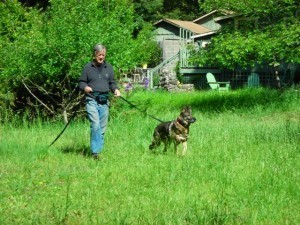 In "the meadow"“Rulers should always avoid giving commands…for commands, being direct and verbal, always bring to the subject’s mind the possibility of doing the opposite. But since rituals are non-verbal, they have no contraries. They can therefore be used to produce harmony of wills and actions without provoking recalcitrance; if a man finds himself playing his appointed part in li [ritual] and thus already — as it were de facto — in harmony with others, it no more occurs to him than it occurs to a dancer to move to a different rhythm than that being played by the orchestra.”
In "the meadow"“Rulers should always avoid giving commands…for commands, being direct and verbal, always bring to the subject’s mind the possibility of doing the opposite. But since rituals are non-verbal, they have no contraries. They can therefore be used to produce harmony of wills and actions without provoking recalcitrance; if a man finds himself playing his appointed part in li [ritual] and thus already — as it were de facto — in harmony with others, it no more occurs to him than it occurs to a dancer to move to a different rhythm than that being played by the orchestra.” Master Zhuang, 4th century BCE Daoist philosopher
and proto-anarchist
That quotation was seminal in creating the anarcho-monarchical politics of the Panarchy, the interstellar polity that’s the setting of the space opera Exordium. The Panarchs and Kyriarchs all wielded theoretically unlimited power, but most of them died, or were killed, before they learn how to work the hyper-complex network of interlocking traditions, institutions, and governance that executes their will.
It’s also, I now find, a perfect encapsulation of the rather Daoist aspects of the positive dog training techniques that Deborah and I are using to rehabilitate Tajji, a process more like conversation than education, and certainly one in which learning flows both ways. Certainly, our work with Tajji is teaching me that much of dog training, if not all, is about the negotiation, establishment, and performance of rituals rather than the issuing of commands.
As Master Zhuang might have said, those who do not acknowledge the power of ritual will find themselves helpless against it, and it can be argued that this is a fundamental reason there are so many ill-trained dogs in the world: dogs that have established their rituals as the rule of life for a household.
Do it again!
Dogs, even more than toddlers, their intellectual “equals,” are creatures of ritual. It is a mistake to view a dog’s identical excitement at “walkies” day after day, for instance, as a failure of either intelligence or long-term memory. To the contrary: try changing some aspect of the ritual and watch what happens. I think that what dogs are doing in these moments can be thought of as celebrating the repetition of a mutual, socially-purposive pattern of behavior: a ritual. (Not all rituals are celebratory, of course. The “waiting for the scolding after poop appears on the floor” ritual is equally powerful, but not pleasant for the dog.)
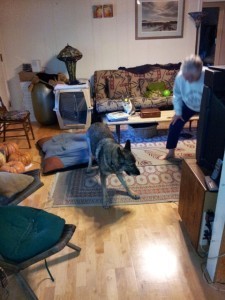 Here, for instance, is Tajji moving through an important initial step in walkies: the refusal of the harness. She is offering a play bow so that we know she will eventually accept the harness, to which Deborah is responding in kind.
Here, for instance, is Tajji moving through an important initial step in walkies: the refusal of the harness. She is offering a play bow so that we know she will eventually accept the harness, to which Deborah is responding in kind.After this is the chase around the table, often with a feint at any cat foolish enough to be in the vicinity.
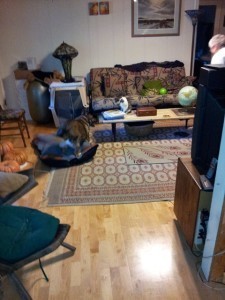
And then acceptance of the harness, signaled by getting on her dog bed.
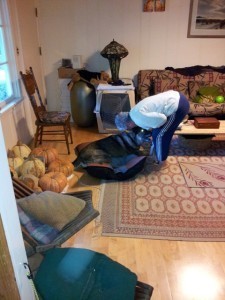
We could have worked to extinguish this behavior; many people would do so reflexively, not considering that the dog has an internal life just as they do, if less complex. In some cases, of course, that would be the right course of action; say, in a busy family where time is more precious than it is for a couple of older writers in the woods.
In fact, initially, we did try and, in fact, we have developed a means of short-circuiting this ritual by inviting her into the mudroom, which is too narrow for her to continue keep-away. But Tajji’s response to a direct command was a kind of mopy, slow obedience, a very clear expression of her displeasure in our opposition to a ritual that was apparently an important part of her previous life as a service dog. Our just-so story about this is that a seeing-eye dog isn’t allowed to refuse the harness, and as she began to decompensate, this behavior likely emerged to both discharge some of the valence accumulating around working in harness, and to communicate her mounting distress. She does not respond in the same way when we simply attach a leash to her collar.
However, on a leash, Tajji is a relentless puller, as are so many dogs. To paraphrase Master Zhuang “Dog trainers should always avoid giving commands…for commands, being direct and physical, always bring to the dog’s mind the possibility of doing the opposite.” Pulling on the leash by the monkey translates to pulling on the leash by dog; it’s practically a reflex. It can also damage a dog’s neck, leading to neurological damage, breathing problems, or even hypothyroidism.
Don’t walk when you can dance
So how, for instance, does one establish the “walk next to me on a leash without pulling” ritual? Here’s an outline of the process we’re following, building on behaviors the dog already possesses innately or has learned as discussed in previous chapters, and rewarding them when the dog offers them.
Choose a proper head or chest harness, the latter preferably a front-clip model to make pulling almost impossible. Our trainer Sandy Pensinger likes Halti’s and similar head harnesses, but Deborah’s former life as a chiropractor and my imagination rule that out for us.
Work in the home, off leash, on the following behaviors, then under increasing distraction. They are to dog-training as genuflecting and blessing oneself with holy water are to catholic Christians.
The most fundamental is “look,” which evokes a dog’s innate desire to check in with “pack members.” If the dog is looking at you, it can’t pull, and is disengaged to some extent from potentially arousing encounters or situations. Make the dog look at you after you put her food down before allowing her to eat. Make look a prerequisite of as many mini-rituals as you can. You want “look” to be a compelling muscle memory for the dog.Couple this with “touch” to an outstretched hand, but not the one with the food. Remember that dogs don’t generalize: Tajji readily learned to touch a hand held to the left or right, but could not immediately translate that into touching a hand held over her head. With a well-developed “touch” command you can literally lead a dog around by the nose; Tajji is already learning to go between my legs using this technique.An urgent recall. “Come” will do, but only if one is disciplined about its use. I find that using the Yiddish hier works better, reserving “come” for a more casual request, like “come along.” Work towards a solid recall with a long leash (I use up to 10 meters) if necessary, but not as a means to haul the dog in. Remember, no commands! Do that which consists of no action, and order will prevail.“Heel,” meaning walk beside me and check in frequently. It doesn’t have to be a rigid positional obedience; check out a Schutzhund OB trial on YouTube sometime and watch the dance between handler and dog.Perhaps most important, “go sniff.” This is a general release, and there’s no reason not to use it at times when the dog is already distracted by a scent. Remember that sniffing the ground is an important calming behavior; a sniffing dog is less easily aroused by a visual cue.Now put it all together. You have look for getting your dog’s attention, touch to guide her through dance rather than compulsion, hier to interrupt trouble (if used quickly enough), heel to establish relaxed walking, and go sniff to let the dog be a dog.Never, never stop training. You are as much a part of the ritual as the dog, and as much its servant. The trick is to build a mutually acceptable “religion” (in the sense of a binding relationship created by ritual and belief) for you and your dog.Do this religiously, and you’ll dance through life with your dog, which is one of the most satisfying modes of being I know of

Published on May 02, 2014 12:19
April 25, 2014
THE HEIR OF KHORED cover
Sometimes, when you first see the cover image for a book you've labored long and hard over, you just want to dig a hole, climb in, and pull a heavy rock over the opening. Other times, it's so gorgeous, so true to the spirit of the book, you can hardly breathe for excitement. That was my joy in this cover. It's not accurate to the details of the story, but it so embodies the central conflict -- and oh my, yes, Shannivar is back!
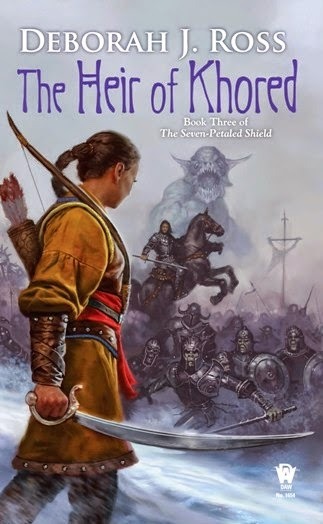
The book comes out in June 2014, but you can pre-order it now. Barnes & Noble, Amazon.com, Powell's or your local bookstore.


The book comes out in June 2014, but you can pre-order it now. Barnes & Noble, Amazon.com, Powell's or your local bookstore.

Published on April 25, 2014 15:37
April 24, 2014
The Tajji Diaries: Doggie Dental Woes
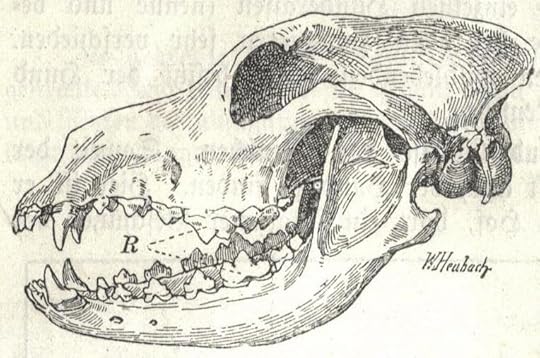 Dogs, like many other carnivores, have specialized teeth for shearing. These teeth come in pairs – an upper and a lower – and are modified fourth premolars (upper) and first molar (lower). The sharp cusps create a scissors-like action, obviously important for chopping up chunks of flesh into pieces that can be swallowed. (Sabertooth cats had carnassial teeth, too – they did not use their elongated canines for chewing!) Apparently, these teeth are particularly susceptible to fracturing and abscesses in domestic dogs. This is what happened to Tajji. She isn’t a “strong chewer,” like our old German Shepherd Dog, but all dogs can exert tremendous force when they bite down.
Dogs, like many other carnivores, have specialized teeth for shearing. These teeth come in pairs – an upper and a lower – and are modified fourth premolars (upper) and first molar (lower). The sharp cusps create a scissors-like action, obviously important for chopping up chunks of flesh into pieces that can be swallowed. (Sabertooth cats had carnassial teeth, too – they did not use their elongated canines for chewing!) Apparently, these teeth are particularly susceptible to fracturing and abscesses in domestic dogs. This is what happened to Tajji. She isn’t a “strong chewer,” like our old German Shepherd Dog, but all dogs can exert tremendous force when they bite down. About three years ago, as near as we can tell from her vet records, Tajji suffered a slab fracture of one of her upper carnassials teeth. The portion of the tooth on the lip (as opposed to tongue) side was broken but not detached. This imageshows a dog with almost the same problem, a slab fracture with a movable chip. Tajji’s fractured tooth was covered with tartar. We had no way of knowing how much discomfort she was in, and how chronic pain might have exacerbated her reactivity. It was clear to both of us that we needed to get to the tooth taken care of. The vet offered to try to save the main portion of the tooth, warning us that the exposed surface would need careful brushing to prevent decay and new buildup of tartar. Rather than risk a problem that required a second dental surgery when Tajji would be even older, we decided to go ahead with extracting this one.
Because Tajji’s reactivity is heightened at the vet’s office, either because of the presence (and smells and sounds!) of so many other animals, or because she associates those smells and sounds with unpleasant things happening to her, we wanted to give her a little extra help, pre-operatively. At our request, the vet prescribed two anti-anxiety medications (acepromazine and diazepam), which we gave an hour before her appointment. She had a little trouble getting into the car, but we have never seen her so calm in the vet’s office. We went with her back to the holding area, where she went willingly into the large crate and lay down. Unlike our old dog, who would yodel in distress when we left him at the vet, Tajji seemed quite mellow. We’re hoping that the relatively easy dropoff will minimize any association between the office and Terrible Things Happening To Dogs.
 Our vet called a few hours later, saying that the surgery had gone well, although Tajji was recovering slowly from the anesthetic. Once the outer, fractured part of the tooth had been removed, the main portion was black and foul-smelling, so it would have had to be extracted in any event.
Our vet called a few hours later, saying that the surgery had gone well, although Tajji was recovering slowly from the anesthetic. Once the outer, fractured part of the tooth had been removed, the main portion was black and foul-smelling, so it would have had to be extracted in any event.We picked Tajji up later that day. She was on her feet but still woozy, with a little blood in her drool and goopy, old-dog-looking eyes (I think because the muscles around her eyes weren’t back up to speed). She spent the rest of the day checked out or being cuddled. She is a dog who loves lots of physical contact, so Dave and I got down on the floor and wrapped our bodies around hers. She’d sigh and relax even further. The next morning, she was interested in breakfast (soft food only!) but not at all her usual energetic self. She’ll be on pain meds and antibiotics for another week or so. For the first dose, we used the usual technique for getting pills into dogs, then decided she’d had her mouth messed with enough for now. So we got some “dog putty” – chicken flavored putty that you wrap around pills – and she happily ate them. Given her age, a slow recovery is nothing to worry about, so long as we see some improvement every day. I suppose that’s one of the lessons about getting older, for us as well as for our animals. Patience and perspective! And looking forward to a future without chronic dental pain.

Published on April 24, 2014 12:35
April 21, 2014
SHANNIVAR sighting - in Singapore!
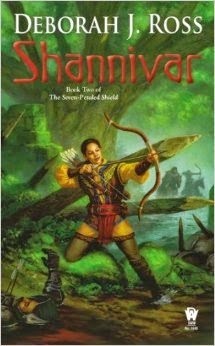 An occasion of unexpected delight: learning that the National Library of Singapore -- Singapore! -- now has Shannivar in their collection.
An occasion of unexpected delight: learning that the National Library of Singapore -- Singapore! -- now has Shannivar in their collection.I wonder whether they buy all DAW books, or epic fantasy...or adventure novels with Asian heroes? Shannivar certainly qualifies, and the cover depicts her as clearly Asian. Wait until they see the cover for The Heir of Khored!

Published on April 21, 2014 11:08
SHANNIVAR sighting - in Singapre!
 An occasion of unexpected delight: learning that the National Library of Singapore -- Singapore! -- now has Shannivar in their collection.
An occasion of unexpected delight: learning that the National Library of Singapore -- Singapore! -- now has Shannivar in their collection.I wonder whether they buy all DAW books, or epic fantasy...or adventure novels with Asian heroes? Shannivar certainly qualifies, and the cover depicts her as clearly Asian. Wait until they see the cover for The Heir of Khored!

Published on April 21, 2014 11:08
COLLABORATORS - Map of Chacarre
For all my readers who love maps, here's the one I drew of Chacarre and surrounding territory. As I wrote Collaborators, I kept a notebook that contained not only story ideas and flow-charts for scenes, but maps and other drawings.
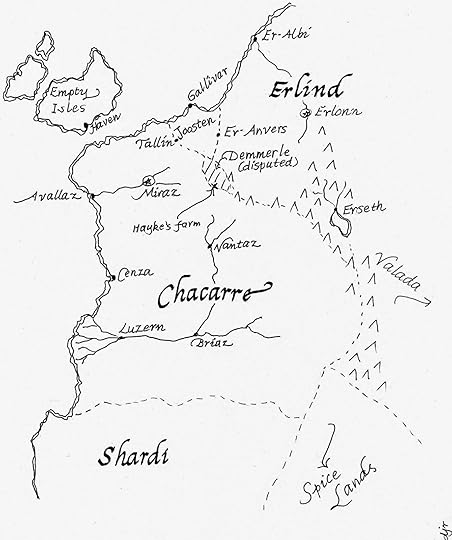
Dotted lines indicate national boundaries. Double lines indicate seacoast. Starred circles are capital cities. The Empty Isles don't have a capital city - they're not nearly organized enough to agree on one. Joosten is also known as the Drowned Lands. The area marked by parallel lines, Demmerle, has historically been part of either Chacarre or Erlind. At the time of the story, it's Chacarran.

Dotted lines indicate national boundaries. Double lines indicate seacoast. Starred circles are capital cities. The Empty Isles don't have a capital city - they're not nearly organized enough to agree on one. Joosten is also known as the Drowned Lands. The area marked by parallel lines, Demmerle, has historically been part of either Chacarre or Erlind. At the time of the story, it's Chacarran.

Published on April 21, 2014 10:05



